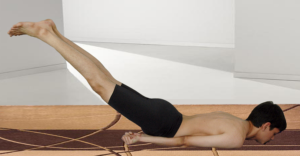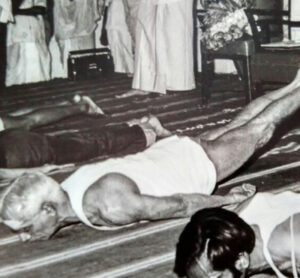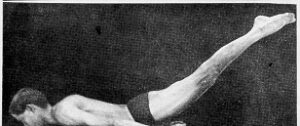What is śalabhāsana (locust pose)?
śalabhāsana or locust pose is where the yogī uses his or her abdominal muscles to raise the legs backwards against gravity. This increase the strength of the back and abdomen.
What is the śalabhāsana technique?

- Sthithi (starting) position: First, lie down on your stomach, face to the floor.
- Second, place hands alongside the body, with elbows close to the sides.
- Importantly, keep the feet together. Also, relax the muscles in the back and abdomen. Exhale slowly.
- Inhaling partially, use the stomach, shoulder and hand muscles to lift the legs off the ground.
- Additionally, keep knees unflexed and feet as straight as possible.
- Remenber to maintain position for 5-10 counts.
- Next, exhale and return to original position.
- Bring hand to the side. Relax.
- Breathe normally. Repeat 3 to 6 times.
- The dṛṣṭi (gaze) recommended is focus on svādhiṣṭhāna-cakra.
What are the benefits of practicing śalabhāsana?

Firstly, this āsana is performed by increasing the tension in the muscles of the abdomen, back, buttocks and legs. As a result, there is increased blood supply to the lower abdomen, colon and rectal area which rejuvenates the muscles and nerves there.
Importantly, the action of lifting the legs using the abdominal muscles increases intra-abdominal pressure. Consequently, this ensures copious blood supply to the intestines and rectal muscles, inducing peristalsis and curing constipation.
Also, the action compresses the buttocks, this results in increased blood circulation to the rectal muscles and anal sphincter. As a result, there is improved evacuation and controlling of ailments such as piles.
Finally, the use of the hands to leverage the stomach muscles results in the toning of the back, neck, shoulder and wrist muscles. Increases the strength and suppleness of the spine.
What are śalabhāsana contraindications?
- Initially, when starting, have someone support the ankles, as you lift them. Since, the abdominal muscles are unused to the reverse lift, you may get stomach cramps or sprains.
- Importantly, if you have any form of back ache, push yourself only to the point where there is no discomfort. When pain or discomfort starts, stop immediately. With practice, the back will begin to flex better.
- Also, practitioners suffering from kidney ailments and vertigo must also be careful not to strain beyond the limits of their bodies.
- Lastly, tince this exercise exerts pressure on the heart, people with cardiac concerns should perform this asana under supervision.
Some noteworthy points on śalabhāsana.

Internal Links: Dharma (conditioning), Prana, Asana overview 1, Asana Focus or gazing,
External Links: Prana, Chakra.
- Significantly, this āsana is considered to be one of the 32 most important asanas by all ancient texts.
- Importantly, the point of focus will determine the benefit accrued from the āsana . In the photograph above, one can see Sundaram keeping his knees straight but the legs are being raised less. In this case, the stomach muscles are strengthened and intra-abdominal pressure is built up, resulting in peristalsis and better evacuation of the bowels. Next to him, Viswanathan is keeping the ankles together but taking the feet higher because the shoulders and lower back are being used to leverage the legs. This position will increase the strength of the lower back.
- Also, the position of the hands is important. When the hands are fully stretched, the abdominal muscles take the strain of lifting the legs, however, if the hands are bent at the elbows, the deltoids provide a reaction support to the abdominal muscles. The latter reduces the efficacy of shalabhasana and should be avoided. Hands should be stretched straight along the length of the body and close to it.
- Lastly, the reason one is asked to take a half breath in śalabhāsana and in mayurāsana is to ensure that the abdomen is not unduly stressed. In complete exhalation, the abdominal viscera would be loosely packed in the abdomen, while after complete inhalation; the abdomen would be tight, leading to stomach cramps. This is avoided by taking a half breath whereby the abdomen is not stressed.
